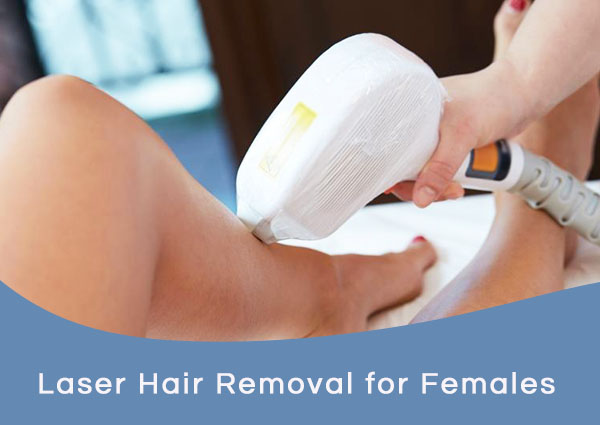Laser Hair Removal for Females

Laser Hair Removal for Females
In this article, you will learn about laser hair removal for females. Hair removal creams range from stinky wastes of time to smelly semi-useful products. Shaving takes time every day and can cause razor bumps and ingrown hairs. And tweezing, waxing, or threading is cruel as well as unusual punishment.
So what can hairy females do to get that silky smooth hairless skin? One choice might be laser hair removal. But before you go for that treatment, there are a few things you should know, which have been discussed in the following article:
How it’s done
Laser hair removal (LHR) may be a medical procedure that uses a beating beam of light to get rid of unwanted hair. The laser goes through the skin to the hair follicle to stunt future growth.
The goal of laser hair removal is to target the melanin in the hair follicle, which is the pigment in the hair follicle. The energy in the laser builds up to coagulate hair follicles so they are unable to produce new hair.
Timing Matters
So it sounds simple. You find someone to zap your hair at the root and no more hair, right? Well, there are several factors to take into account in considering LHR, including when you should start.
Hair grows in different phases. The growing phase — anagen — is the time that we want to effectively target. Hair growth occurs in a three-phase cycle — anagen (growth), telogen (dormant), and catagen (death). The laser cannot identify the hair when hair is in the telogen phase. Unfortunately, hair growth doesn’t occur all at once. That’s why it’s important to space out treatment to every four to six weeks.
For the average patient, we recommend four to six treatments at least four to six weeks apart. That generally gets rid of the majority of the hair.
Skin Color Affects your Treatment
It shouldn’t be much of a surprise since melanin is involved, but women of darker skin color should be aware that their color might impact their hair removal outcomes. The reason darker-skinned people might have difficulty with hair removal is the laser can’t differentiate between the pigment in the skin and the pigment in the hair follicles. With the laser unable to distinguish between the hair follicle pigments and the skin pigments, patients can experience side effects. However, the latest laser technology can target pigment in hair follicles while minimizing any targeting of pigment in surrounding skin in darker skin types.
Side effects can include blistering, cold sores, swelling, scarring, and darkening of the skin. Tanning and tanning spray also impact the efficacy of the hair removal process. It’s recommended to wait several weeks after a tanning session to allow the skin to go back to its natural color. Regarding this Laser hair removal in Delhi is doing great work.
Hair Color makes a Difference
When it comes to LHR, blondes don’t have all the fun. Females with lighter colored hair might not be suited for laser hair removal treatment. Since laser hair removal targets the pigment in the hair follicle, the less pigment there is, the harder it will be for the laser to find the hair.
Not all blondes need to worry. The concern is more for individuals with very fair hair like those with white, gray, or pale blonde hair. When there is a patient who comes in with white hair or pale-colored hair doctors often tell them ‘you’re wasting your money don’t get laser hair removal.’ In such cases, electrolysis would be a much better choice.
Many physicians treat women with blonde hair on a case-by-case basis. In cases where a doctor discusses LHR with patients, there is an ideal candidate in their mind. “An ideal candidate is a person with darker hair on a fairer complexion”. They are called ‘ideal’ because the laser is able to effectively target the majority of the darker brown or black hair against the contrasts of the fairer complexion.
Hair Removal isn’t Permanent
It is important to note that LHR is permanent hair reduction, not permanent hair removal. Some patients do experience breakthrough hair growth after the treatment series.The only hair removal process approved by the US Food and Drug Administration (FDA) as permanent hair removal is electrolysis. However, electrolysis might not be the best option. “Electrolysis destroys the hair follicles one by one. It’s painful and intensive for the patient and practitioner. That is why laser hair removal is preferred.”
Though laser hair removal is not permanent, studies do show it may be extremely effective. A study found that there was a 90% median reduction of hair in Chinese women who used a certain type of laser hair removal.
The Type of Laser Matters
Though there is an “ideal candidate” — dark hair and fair skin — the industry now has a range of LHR machines to treat varying hair and skin colors. There are four common hair-removal lasers. Doctors always recommend consulting a dermatologist to decide what laser would work best for your skin and hair.
For darker skin, there is the Nd: YAG Laser. It is ideal of darker skin hues because of its weaker melanin absorption. To get rid of the hair, YAG sends out long wavelengths to zap the hair. Because YAG absorbs less melanin, it needs a lot of treatment and has been found to be less effective for ladies with fine hair. Regarding this Laser hair removal in dwarka are do their job so well.
Those with an olive tone; Alexandrite Laser has been found to be effective. Similar to the YAG Laser, Alexandrite transmits a long wavelength. While effective for women of varying complexions, Alexandrite has been found to cause scarring.
The Diode Laser, which was used in the hair reduction study in China, is a newer product that is ideal for lighter-skinned women. It uses a mix of short and long wavelengths to attack the hair follicles. Because Diode is so new, there is little known about its long-term effects. For very light skin, females can turn to the Ruby laser system. It’s one of the oldest systems around. It has a higher melanin absorption rate than other options. However, patients report discoloration after treatment.
